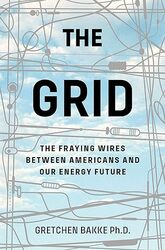
Rating: 8.3/10.
Book about the electricity grid, focusing on America and its history. Though the grid is usually hidden away in our lives, it is actually a complex arrangement of different local systems that has physical constraints, as all power generation must match usage at all times because it is not possible to store large amounts of energy. Much of this infrastructure is under stress due to aging and low maintenance requirements, which is resulting in an increasing amount of outages.
Since electricity largely cannot be stored, the amount of generation and demand must always match. This poses a problem for renewable energy like wind, where too much excess energy can suddenly crash the grid, and operators have to rush to turn them off. We still need generators based on diesel, natural gas, and other fossil fuels because they can be turned on and off quickly when needed and work regardless of the weather.
The first electrical grid started in the 1880s by Edison and others, mostly for lighting, and there were many variations as people debated the merits of serial versus parallel circuits, direct versus alternating current, voltage and frequency, etc. Many small grids were initially sold to individuals and business owners rather than as public utilities, with many incompatible standards, and eventually AC won out over DC due to being better suited for long-distance travel.
Around the 1910s, electricity providers began to centralize in each district rather than having lots of individual grids, with Samuel Insull who took over Edison’s company pioneering the infrastructure effort. Efficiency continued to increase and the number of customers grew up until about 1970, when it started approaching thermodynamic limits and hit diminishing returns. Currently, there are many regulations that control pricing and prevent municipalities from splitting away from the central grid.
In 1978, the new legislation PURPA eliminated the monopoly position of electricity producers and mandated that they must buy electricity from smaller providers at a predetermined rate. This opened the door to many alternative energies that could be profitable, such as wind farms in California in the 1980s, which received substantial investment although the generation efficiency at that time was poor.
August 2003 witnessed one of the worst blackouts in history due to a combination of multiple factors, with the blame largely falling on Ohio’s First Energy, which had skipped routine maintenance and allowed trees to overgrow and short-circuit power lines. The situation was exacerbated when the computer monitoring systems failed, leaving operators unaware of the problem for several hours until neighboring power systems started experiencing huge power surges and reached First Energy’s operators by phone. An issue is that all parties profit by providing electricity; however, the investments needed to maintain system stability tend to be less profitable and are often deprioritized.
Smart meters attempt to track energy use continuously, rather than just once a month, which saves on human effort needed to read the meters. This technology also allows utilities to price peak versus off-peak load differently, and in some cases, they can remotely turn off air conditioning and other appliances to reduce the load. While this makes economic sense for the utility companies since peak demand is usually the most expensive, it conflicts with consumers’ desire to avoid thinking about electricity and have things work when they’re supposed to. The combination of privacy concerns and higher electricity bills after smart meters were installed led to protests against smart meters in Colorado where a pilot project was attempted.
Many people have started to run their own microgrids to improve power reliability after experiencing blackouts for days, eg after Hurricane Sandy; these are usually supplemented by the grid but provide electricity when the grid goes down. Electricity in the US is surprisingly fragile, with many instances of weather, animals, and criminal activities taking down the power for days.
The major problem with green energy is that solar has a timing mismatch between daytime generation and nighttime demand – the peak electricity demand is between 5 to 10 PM but 5PM is when the sun starts to go down. In Hawaii, those with solar panels get electricity rebates, but they are still reliant on the grid due to this timing mismatch; as a result, the cost of maintaining the grid falls disproportionately on lower income groups who cannot afford solar panels. Despite just a few hours of delay, storing this energy using batteries is extremely difficult. An idea that has been proposed is using electric vehicle batteries as a buffer between daytime supply and nighttime demand, but this idea has not seen widespread adoption.
The author concludes by imagining that the future of the grid is becoming more efficient but in an invisible way by default, as technology is improved, electricity is produced and distributed efficiently, without us having to think about it too much. The author imagines that this is the case rather than a future where everybody has to be cautious about electricity usage.
Overall, a very relevant book about the state of the electric grid, defined by its history and physical constraints and how it’s surprisingly fragile. The writing is somewhat verbose, but generally well written and well researched. This feels quite relevant to me due to moving to a place from Vancouver to Bellevue, where the cost of electricity is several times higher, and helps contextualize the differences in power generation between these two areas.


